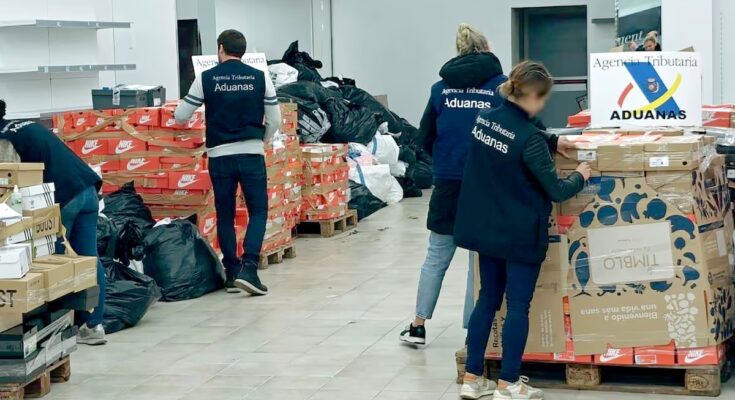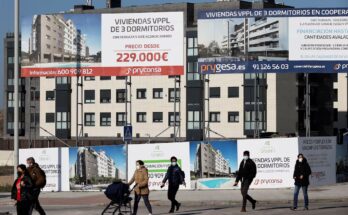At the end of 2023, the Revenue Agency intercepted two containers from Shanghai (China) bound for Algeria in the port of Valencia. It contained more than 300,000 counterfeit watches imitating models of recognized brands such as Rolex, Versace, Hublot or Lacoste. Part of the goods were destroyed and the rest is waiting for what the judge will decide. The over 300 million euros worth of that shipment, however, have already been accounted for in the statistics on the prevention and control of tax and customs fraud corresponding to 2024. And they have inflated the registers of the Ministry of Finance to levels never seen before.
The Valencia discovery triggered the parameters. In 2024, the overall value of all counterfeits encountered by the Revenue Agency – including fashion, luxury products, toys, medicines or cosmetics – rose to 406 million euros, an unprecedented figure in the series of the body dependent on the Treasury which confirms that the imitation business has not only spread, but has become sophisticated.
The Revenue Agency details in its annual reports both the number of counterfeits intercepted at customs and in anti-smuggling actions, and the financial amount assigned to the operations. This value, explains the Association of State Treasury Inspectors, does not derive from expert assessments, but from the market price of the authentic product that you are trying to replicate. If a watch costs 1,000 euros in an authorized retailer, the fake that imitates it is assigned the same value. It’s that simple.
In 2024, just over 1.3 million counterfeit items were seized. It is not a particularly high figure compared to other years, but it leaves an average value per product of 306 euros, the highest since it was recorded.
Behind each of these operations lies a legal and administrative mechanism that determines what is considered counterfeiting, how it is valued and what the final destination of the seized goods is. The Revenue Agency and its customs and customs surveillance departments have direct jurisdiction to identify and take action against products that infringe intellectual property rights. They can do so on their own initiative, when they detect goods suspected of infringing an intellectual property right, or following a request for intervention previously presented by the owner of the right, as the inspectors recalled.

However, explains Carmen González, head of the trademark and patent management area at Baylos, the real backbone of the system is European legislation. A 2013 community regulation establishes how customs must proceed when they suspect that goods are counterfeit or imitate a registered trademark. Thanks to this common framework, actions are coordinated across all ports and airports in the internal market, with very similar procedures in each Member State.
The process, González continues, begins long before the counterfeit reaches stores or distributors. Risk analysis units scan thousands of shipments and, when they find signs, from anomalous labeling to the habitual importer of sensitive goods, they block the goods and immediately notify both the exporter and the allegedly infringed brand. Both parties have 10 days – or three for perishable goods – to analyze the product and decide what to do.
At this moment two possible paths open up: if both parties agree, the destruction will be carried out without judicial intervention and under customs control. If the registrant objects to such destruction, the trademark owner will have to initiate civil or criminal proceedings to ascertain whether infringement has occurred. The parties may request a further period of 10 days. And if the allegedly counterfeit brand does not take legal action, customs releases the goods. In the case of the watches intercepted in Valencia, the Revenue Agency underlines, there were brands reported and others not.
The fate of fakes, therefore, is almost always sealed from the beginning: if there is an agreement between the parties or the silence of the importer, they are destroyed under customs control. Only a few cases end up in court, usually those of greater economic significance or when there are additional crimes, such as the fraudulent use of seals or the impact of sensitive products such as healthcare products.
Baylos’ lawyer explains that, as a general rule, companies that deal in counterfeit products usually agree to destroy the products. It is a risk they accept, he suggests, because they know that the Revenue Agency does not have the means to check all shipments entering or passing through Spain. So when you fall, you consider yourself lost without too much trouble. For this reason, González continues, big brands usually collaborate closely with customs to tighten the siege on this activity. They do this by providing catalogues, records, models and technical details that facilitate the rapid identification of imitations. They themselves also bear the costs of destruction.
From cosmetics to toys
In recent years, adds González, we can perceive a process of sophistication of imitations. The sectors most affected are textiles, from clothing to bags, and luxury, although the toy sector also has a very seasonal impact, especially in the months preceding Christmas. Tobacco, alcohol or perfumes are usually also found.
The trends observed in Spain coincide with the European diagnosis: the counterfeiting business not only grows in value, but also becomes more complex and transversal. The European Commission’s report on the enforcement of intellectual property rights in 2024 confirms a historic record in the value of seized assets and a growing presence of high-end products, technology items, cosmetics and leisure. It also indicates greater sophistication of networks, the use of different logistics routes and the entry of new transit countries. China and Turkey, for example, have been joined by the United Arab Emirates.
In this context, the actions of the Spanish Revenue Agency do not constitute an exception, but are part of a coordinated strategy at European level, based on harmonized procedures and a constant exchange of information. The European report highlights that more than 80% of interventions in the EU end with the destruction of goods and that cooperation between customs, police forces and rights holders is essential to tackle an increasingly globalized phenomenon.



